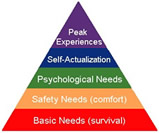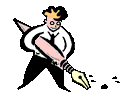Summer 2016 Guidance 1/Psychology 5 Part 1 - Lecture |
Your Career Fitness Profile: Survey Your Strengths |
|
We will be using the Career Diamond model to help visualize the process of engaging in career decision-making. The model emphasizes the importance gathering information about yourself and the world of work. This learning integrated with your personal vision must be used to make a good career decision. Selecting a career that is a good fit for who you are and who you want to be in the context of our employment market takes some time and patience. According to Sukiennik, Bendat, and Raufman (2013, The Career Fitness Program-our class text), a career is a "sequence of attitudes and behaviors associated with work and that relate to our total life experience. A career is really an integration of our personality with our job activities." (page 9).When the integration of the work and person occurs individuals are amazed that they actually get paid for doing the things they love. A job is a position of employment within an occupation; an occupation is one's vocation, business, calling, profession, or trade; and lastly, a career is a sequence of a person's work experiences over time. For example, my husband's current job is a network administrator, his occupation is Information Technology, and his career path has led him from being a computer technician to currently a network administrator. Our task in this class is to help you identify a career and a career path that is congruent with your self-concept. |
|
Sometimes, throughout a lifetime, we have jobs that are in occupations that are not in support of our career plans. For example, I worked as a waitress while attending college and although my career goals were directed elsewhere, I needed the job. At that time in my life, I needed to pay for my school, rent, and food. I did not have the education or work experience to obtain a job in my chosen career field and being a waitress met my basic needs during that period of my life. Abraham Maslow would say that taking care of basic needs like having food, water, and shelter supersedes all other needs and before anything else can take place, those basic needs must be met. Identify were you are on Maslow's hierarchy of needs.
Career development occurs in stages. Dr. Donald Super, psychologist and expert in career development throughout the life span, identified five major stages that we move through when we are making career decisions: Growth, Exploration, Establishment, Maintenance, and Disengagement. Each stage has tasks that must be completed prior to moving to the next stage of career development. Also, according to Dr. Super, a successful career development process requires that individuals have the ability to identify and implement their self-concept. Your self-concept is how you see yourself. Identifying the self concept is the top of the Career Diamond - it is learning about your values, personality, interests, skills, etc. Implementing your self-concept is when you are doing the work that best expresses who you are (self-concept). Super also proposes that a person can re-cycle through the career development stages several times throughout the life span. In other words, you can be a 25 year old adult who is still in the growth stage, learning more about yourself and career opportunities. Or you can be a experienced professional who is in the disengagement stage of your current career but who is now thinking about embarking on some type of new work that fulfills your altruistic needs or expresses your self-concept more completely. This person will also also go through the growth stage of career decision making. View it much like multiple career diamonds: you move through the career diamonds at different stages of life. Read the descriptions of each of the stages of career development. Most of you may be in the growth stage in which you are exploring the world of work and how you fit into it. This is likely the reason you registered for this class. This growth stage helps us realize our likes and dislikes about work. We become aware of the work environment that is best suitable for us to excel. This stage contributes to the attitudes and behaviors that will form your career self-concept. Your career self-concept evolves in the work you do and experiences. View the summary of Super's Career Development Stages; can you identify your stage? Reflect on your life and career development stages, how prepared are you to move forward, to make decisions about your future? Keep in mind that the goal of this class is to teach you how to engage in a process that will allow you to identify options that are aligned with your self-concept, personal vision, and career and life stages. You will use these skills during different periods of your life. Assuming that you are at the top of the Career Diamond model, at the growth stage of career development, the information that you will gather about yourself in this class will be very useful - revealing and interesting. The information you collect will confirm information you may know about yourself - the assessments will provide you with some additional understanding and the vocabulary to help describe yourself. The outcome of these assessments will also begin to show you some common occupational themes. The themes will help you get a clearer vision of who you are, now at this time in your life, because as you continue to have different experiences and mature in your career, your understanding of yourself may adjust. |
|
As you gather information and complete the various surveys and assessments available in this lecture and the text, please keep in mind some key points about assessment instruments; view "Seven rules about taking Career Tests" by Richard Bolles. |
|
Learn to write SMART Goals.
Write your goals using "I statements". I statements are positive and promote self-responsibility. David Ellis, author of College Survival Skills, identifies four categories of goal statements, each successively demonstrating levels of commitments.
Evaluate your commitment level when writing goals. Category 4, Statements of Promise, are the most compelling and most powerful of goal statements. You will have the opportunity to write some of your own goal statements next week. Writing down your goals is a valuable step to achieving your career goals. |
|
Four categories of goal statements: Category 1 - Statements of Possibility
Category 2 - Statement of Desire
Category 3 - Statement of Intent
Category 4 - Statement of Promise
|
|
At the conclusion of Part 1 of this course, you will recognize that you are a very unique individual. You have
specific preferences (personality, work and learning environment, risk taking,
team orientation, and leadership style), skills, interests and confidence
levels.
You will also have an understanding of your values, your self-esteem level, and some of your best traits. You will be able to identify areas that you may want to develop further. For most, this will be a revealing experience- hopefully you begin to see yourself differently, more dimensionally, and more comprehensively. Others may already have a "gut" feelings about likes and dislikes, what kind of person they are or want to be, or the kinds of career fields that are interesting. My hope is that each of you can now begin to articulate what you know about yourselves and use that information to increase confidence levels in order to include or exclude specific career options. The assessments you've completed should help to crystallize a picture of you at this time in your life. As you gain more experience -life and career- and move through life stages, you will need to re-assess yourself; use the career diamond model as a visual of the steps that you must take through the recycling process of career development. When you analyze the information you have collected about yourself, look for patterns or themes. See if you can identify your personal mission or vision statement from what you have learned. As you begin to look at the information you have collected, take that which you can relate to - select the assessments that you related to more closely with and set the rest aside. Try to focus on "what is", the "possibilities", your strengths. Some of you will find conflicting information about yourselves- for example, in one assessment you were an Introvert, in another, your were a Extrovert - my suggestion is that you look at the descriptions carefully, and select the preference that you gravitate toward. You also identified many skills, select those skills that are most predominate for you, the one's you would share in a job interview. Part Two of the class, using the Career Diamond Model, we will begin to learn about the world of work. We will look at the reality of our working world, what it takes to prepare for specific careers, and answer looming questions most students have: will there be a job for me after I finish school and what will my earning potential be like? |
|



 "I will research 3 career options by the end of the term."
(Does this statement contain the SMART components? )
"I will research 3 career options by the end of the term."
(Does this statement contain the SMART components? )